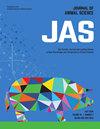对精确饲喂标准回肠可消化赖氨酸和其他氨基酸以确定和满足哺乳母猪需求量估计值的评估
IF 2.7
2区 农林科学
Q1 AGRICULTURE, DAIRY & ANIMAL SCIENCE
引用次数: 0
摘要
有两项实验评估了泌乳期精确饲喂标准化回肠可消化(SID)赖氨酸的效果。母猪在泌乳期第 2 天按胎次分群并分配到不同的处理中。在这两项实验中,都对母猪的体重(BW)、背膘(BF)、腰深(LD)和估计的氮排泄量以及仔猪的生长性能进行了评估。在实验 1 中,使用了 95 头母猪和仔猪。使用两种日粮进行了三种日粮处理:低赖氨酸日粮(0.25% SID Lys)和高赖氨酸日粮(1.10% SID Lys)。处理包括在整个泌乳期饲喂对照日粮(1.10% SID Lys),以及 NRC 或 INRA 处理曲线的 Lys 摄入量。使用计算机化泌乳饲喂器(Gestal Quattro Opti Feeder,Jyga Technologies,St-Lambert-de-Lauzon,Quebec,CA)饲喂 NRC 或 INRA 处理曲线的母猪可获得低 Lys 和高 Lys 日粮的混合物,以便在泌乳期每天根据 NRC 和 INRA 的奇数和窝产仔数模型确定特定的 Lys 摄入量。在实验 2 中,对 56 头母猪和产仔数进行了三种处理:对照日粮(整个泌乳期饲喂 1.10% SID Lys)以及静态或动态混合曲线。在这两种曲线处理中,低赖氨酸(0.40% SID Lys)和高赖氨酸(1.10% SID Lys)日粮混合以达到目标赖氨酸摄入量。静态曲线和动态曲线的区别在于,动态曲线是根据实际赖氨酸摄入量进行调整的,而静态曲线则不是。赖氨酸摄入量曲线是基于 NRC 模型的估计值,但目标值提高了 20%,即根据实验 1 的结果,各年龄组的平均赖氨酸摄入量为 60 克/天。在这两项实验中,均未观察到母猪日平均采食量或母猪体重、BF 或 LD 变化的差异(P > 0.05)。与饲喂任何一种混合处理曲线的母猪相比,饲喂对照日粮的母猪有更多的赖氨酸摄入量(克/天;P & lt; 0.05)。在实验 1 中,与饲喂 INRA 处理曲线的母猪相比,饲喂对照日粮的母猪断奶时的体重和断奶前平均日增重(ADG)更大(P &P;lt;0.05),饲喂 NRC 处理曲线的母猪的体重和日增重介于两者之间。然而,在实验 2 中,没有观察到断奶时体重和平均日增重的差异(P > 0.05)。在这两项实验中,饲喂混合处理曲线的母猪计算出的氮排泄量较低(P < 0.05)。总之,对于一窝 13.5 头断奶猪来说,60 克/天的 SID Lys 足以最大限度地提高窝增重,而且可以通过混合低 Lys 和高 Lys 日粮来实现。与整个哺乳期饲喂单一日粮相比,精确饲喂可减少氮的排泄。本文章由计算机程序翻译,如有差异,请以英文原文为准。
Evaluation of precision feeding standardized ileal digestible lysine and other amino acids to determine and meet the lactating sow’s requirement estimates
Two experiments evaluated the effects of precision feeding standardized ileal digestible (SID) Lys during lactation. Sows were blocked by parity and allotted to treatment on d 2 of lactation. In both experiments, sow body weight (BW), backfat (BF), loin depth (LD), and estimated N excretion were evaluated as well as litter growth performance. In Exp. 1, 95 sows and litters were used. Three dietary treatments were provided using 2 diets: a low (0.25% SID Lys) and high Lys diet (1.10% SID Lys). Treatments included a control diet (1.10% SID Lys) fed throughout lactation, and NRC or INRA treatment curves for Lys intake. Sows fed NRC or INRA treatment curves received blends of low and high Lys diets using a computerized lactation feeder (Gestal Quattro Opti Feeder, Jyga Technologies, St-Lambert-de-Lauzon, Quebec, CA) to target a specific Lys intake each day of lactation based on NRC and INRA models for parity and litter size. In Exp. 2, 56 sows and litters were used with three treatments, a control diet (1.10% SID Lys fed throughout lactation) and either a static or dynamic blend curve. For both curve treatments, low (0.40% SID Lys) and high Lys (1.10% SID Lys) diets were blended to reach target Lys intake. The difference between the static and dynamic curves was that the dynamic curves were adjusted based on actual Lys intake and static curves were not. Lysine intake curves were based on NRC model estimates, but targets were increased by 20% to target average Lys intake of 60 g/d across parities based on results of Exp. 1. In both experiments, no differences (P > 0.05) in sow average daily feed intake or sow BW, BF, or LD change were observed. Sows fed the control diets had greater Lys intake (g/day; P < 0.05) compared to sows fed either of the blended treatment curves. In Exp. 1, pigs from sows fed the control diet had greater (P < 0.05) BW at weaning and preweaning average daily gain (ADG) compared to sows fed the INRA treatment curve, with pigs from sows fed the NRC treatment curve intermediate. However, in Exp. 2, no differences (P > 0.05) were observed in pig weight at weaning or ADG. In both experiments, sows fed the blended treatment curves had lower (P < 0.05) calculated N excretion. In summary, for a litter size of 13.5 weaned pigs, 60 g/d of SID Lys is sufficient to maximize litter weight gain and can be achieved through blending low and high Lys diets. Precision feeding reduced N excretion compared to feeding a single diet throughout lactation.
求助全文
通过发布文献求助,成功后即可免费获取论文全文。
去求助
来源期刊

Journal of animal science
农林科学-奶制品与动物科学
CiteScore
4.80
自引率
12.10%
发文量
1589
审稿时长
3 months
期刊介绍:
The Journal of Animal Science (JAS) is the premier journal for animal science and serves as the leading source of new knowledge and perspective in this area. JAS publishes more than 500 fully reviewed research articles, invited reviews, technical notes, and letters to the editor each year.
Articles published in JAS encompass a broad range of research topics in animal production and fundamental aspects of genetics, nutrition, physiology, and preparation and utilization of animal products. Articles typically report research with beef cattle, companion animals, goats, horses, pigs, and sheep; however, studies involving other farm animals, aquatic and wildlife species, and laboratory animal species that address fundamental questions related to livestock and companion animal biology will be considered for publication.
 求助内容:
求助内容: 应助结果提醒方式:
应助结果提醒方式:


